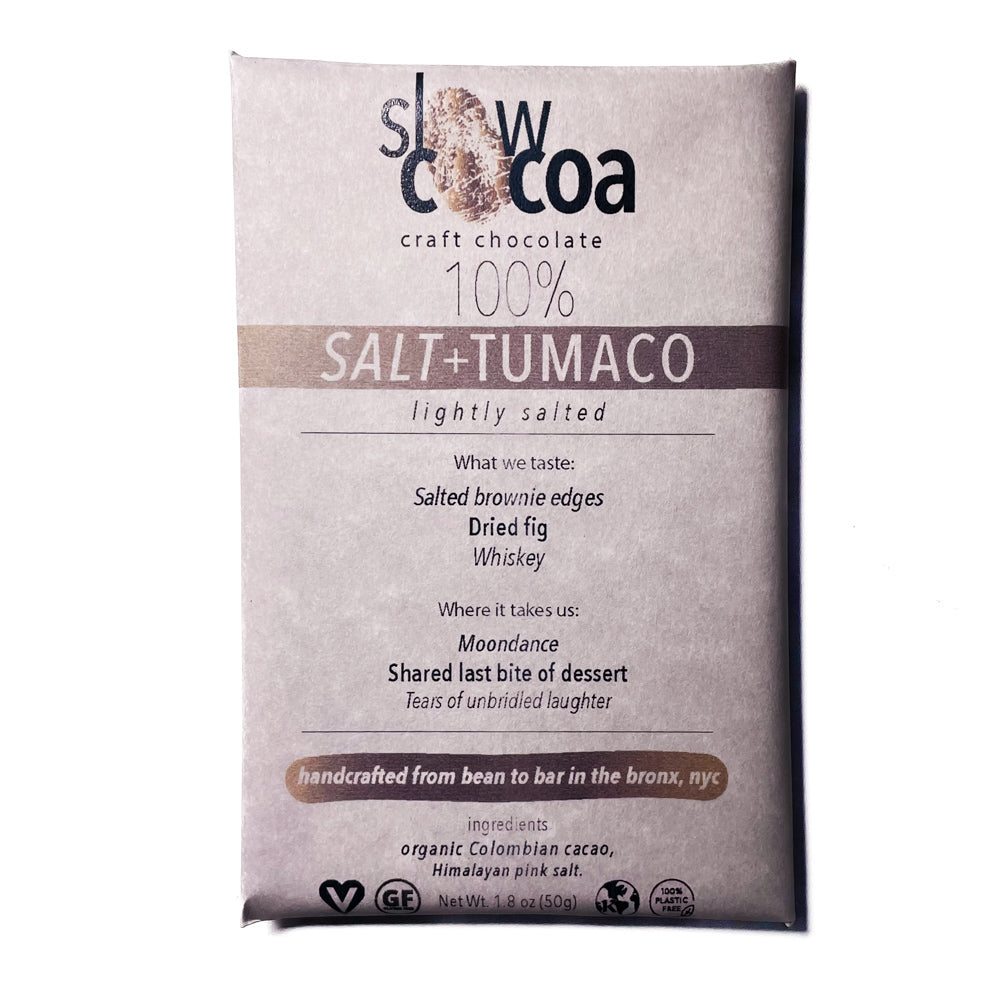100% Salted Tumaco
Same as our classic 100% Tumaco, but oh, so different.
A sprinkle of pink Himalayan salt on the back of this bar truly transforms the Colombian-origin cacao into an even more snackable, deeply satisfying, energizing, flavorful, and potent boost of all the magic cacao can offer.
Rest assured: there's no actual dried fig or whiskey or brownies in this bar. Like all our dark chocolate, the "tasting notes" aren't ingredients, but rather – like a fine wine, single-origin coffee, or truly any other complex multisensory stimuli – examples of what the chocolate reminds us of, and where it takes us.
And oh, does this chocolate remind us: to first "chew, then stew," as we say; to invite flavors to slowly unfold as the cacao melts on the palate and melds into the memories that inform our impression.
(Moondance choreography not included. :)
Organic Colombian cacao, Himalayan pink salt.
Made in a fully vegan, gluten-free facility powered by 100% renewable wind energy.
The Tumaco region in Colombia is renowned for its unique cacao genetics. Local producer associations have taken the initiative to establish clonal gardens, aiming to delve deeper into understanding and propagating the distinct cacao genetics scattered throughout their surrounding forests.
Our most recent cacao harvest from Tumaco was a collaborative effort of ASPROCAT (Asociación de Productores Cacaoteros), one of four prominent associations in the Tumaco-Nariño region, comprising a network of nearly one thousand families dedicated to growing cacao.
To ensure consistency and superior flavor, the beans were meticulously blended by our export partners Cacao de Colombia, also known as Cacao Hunters. This organization collaborates with seven associations in total, sourcing high-quality cacao for export and for their own chocolate production within Colombia. The flavor profile of this cacao is notably characterized by rich undertones of chocolate ganache, almond butter, and a hint of green apple – transformed through our process, including the addition of unrefined coconut sugar, to carry the curious hints of molasses slowly morphing into whiskey.
Where are these flavors coming from? A large part of postharvest flavor development happens at the earliest stages of cacao production, with variables often summed up by the term “terroir” (French for “land”) – a reference to the soil composition, farming practices, and general growth habitat of a particular crop that come together to create something of an agricultural stamp — alongside the human labor that alchemizes the cacao bean into flavor-rich chocolate.
In this case, the crops that surrounded our Tumaco cacao prior to harvest – or, more accurately, that were used for intercropping – include banana, plantain, citrus, timber, avocado, yuca, coconut, vanilla, and guanábana (soursop). ASPROCAT also proudly maintains a clonal garden to highlight the region’s genetic diversity, including rare “criollo” strains endemic to Tumaco. The garden also serves as an educational hub for cacao producers in the region.
Beyond ensuring a regenerative agricultural environment, the producers enact strict quality standards throughout the postharvest process, including sugar analysis of the wet (pre-fermented) cacao at the point of purchase, monitoring of temperature, pH and sugar levels across key stages of fermentation, and cut tests during fermentation – all of which contribute to preserving and highlighting as much flavor precursors as possible (remember, we still gotta roast, refine and conche these beans once they reach us in nyc).
Since 2018, our export partner Cacao de Colombia has provided essential feedback and technical assistance on the post-harvest practices that have allowed this cacao to demonstrate consistent traceability and quality standards, as certified and reported by our friends Uncommon Cacao in their annual transparency report.
Many hands, families, and years of human labor to help these beans sing!


